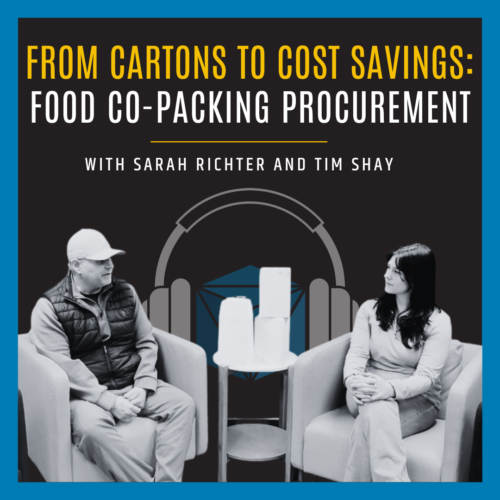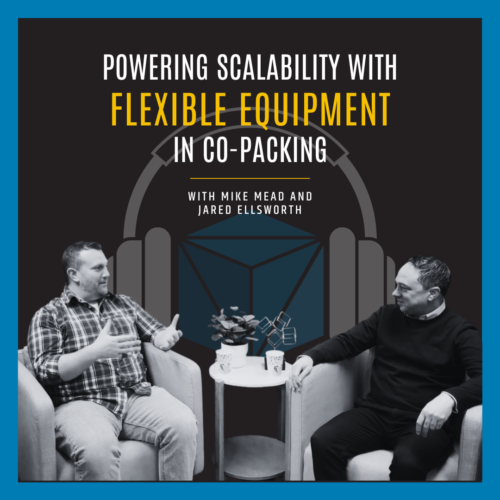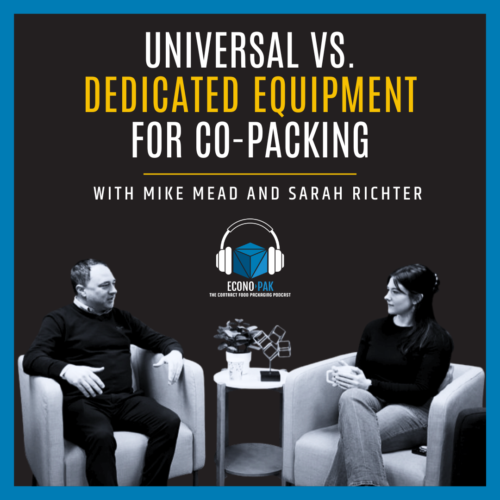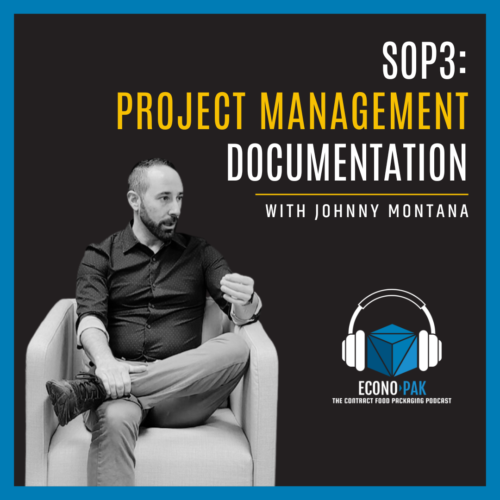Requesting a Fixed-Price Quote with COO Ed Horn
Ed Horn, the Chief Operating Officer (COO) of Econo-Pak, delves into his extensive experience with Econo-Pak. He discusses the evolution of the co-packing industry, the significance of our request a quote form, and the intricate workings of Econo-Pak’s operations.
Ed also touches on our request a quote form and best practices when filling it out for your project. With over 17 years at Econo-Pak, Ed brings a wealth of knowledge and expertise, offering a unique behind-the-scenes look at the company’s approach to efficiency, quality, and innovation.
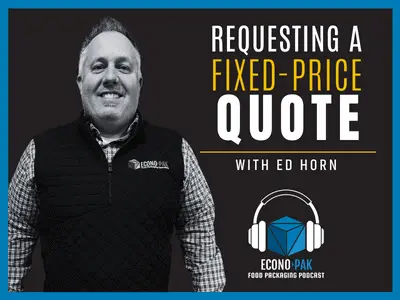
Contract Food Packaging with COO Ed Horn
Sarah Richter:
Welcome to the Econo-Pak Food Packaging Podcast. Today we’re talking with Ed Horn, our COO. We talk about Ed’s experience at Econo-Pak, how the co-packing industry has changed, and why the request a quote form is so important. Let’s get into the show. Thanks for joining us, Ed.
Ed Horn:
Thank you guys for having me.
Sarah Richter:
How long have you worked at Econo-Pak?
Ed Horn:
I’ve started working at Econo-Pak in August of 2007, so this year I’ll be going on 17 great years.
Mike Mead:
Wow.
Sarah Richter:
And so what does a COO do every day?
Ed Horn:
My job is to try to make our job and our lives as efficient as possible. So it comes down to office staff, it comes down to the floor, picking the right equipment for the right jobs and making sure those people are on there, and also making sure that those people and those pieces of equipment actually work well for our clients and the pricing models we put together for them.
Mike Mead:
Yeah, that’s incredible. You said 17 years, so you’ve obviously seen the company transition over 17 years. It’s changed.
Ed Horn:
It’s been amazing. It has changed a tremendous amount. Initially, our facility was much smaller than the current one, so every year you see huge expansions going on, trainings, the number of people. It’s just been really amazing.
Mike Mead:
Yeah, that’s great.
Fostering Positive Culture in Co-Packing
Sarah Richter:
I know we have a really great culture, not only in the front office, but also in production as well. What do you do to help foster that?
Ed Horn:
The people out on the floor are the backbone of the company. We all have a good time, but it’s really being positive with those people. Smiles are contagious and it goes along with everything and just making sure our people are happy, that they understand what we expect of them and promoting that and having them promote that to other people. We don’t like to tolerate any bad eggs.
Sarah Richter:
In your time here, you’ve seen quite a few people go from working on the line to, for example, Patrick becoming plant manager. Is that part of what you were talking about?
Ed Horn:
Absolutely, yes. We absolutely try to promote within when we can in this day and age. There are other positions that need to be filled that we may not have in-house, and that’s when we go out of house. But a lot of the people we have are homegrown. So they understand everything from the bottom to the top, and it really helps us as a company do the best we can for our clients.
Mike Mead:
Yeah, definitely. You see it, like you said, smiles are contagious when you walk around, people are motivated by that. They like when they’re recognized for doing a good job.
Ed Horn:
They’re happy to be here.
Mike Mead:
A cookie dropper, just somebody that works on one of the lines to even the people in the front office. Everybody plays a really important role in our success, and a lot of that’s driven by a culture from your executives in the company.
Ed Horn:
100 percent.
Changes in the Co-Packing Industry
Sarah Richter:
And we had a conversation with PJ about the future of co-packing, but I’d like to hear in your 17 years here, what have you seen change in the industry?
Ed Horn:
Well, quality is one of the bigger portions of what I see has changed. So adapting to those new requirements, there was no such thing as SQF when I started. It was we had audits, we had internal audits, we had things of that nature. But then moving on to SQF Level 1 through 3—we are SQF Level 3—and we took that upon ourselves to go that extra mile to make it even better. Food safety is number one for us, but looking at quality and the people, we had a much smaller staff back then.
Now, we have 45 plus staff in quality, different levels and layers within that quality department, and also just the certifications required. So it’s pretty amazing how far that has come, but that’s one. The other one is equipment. Back in the day, and I say back in the day, it’s 17 years ago, the equipment was very antiquated. We’ve come so far with automation and just being able to produce things faster, but still maintain that high level of quality for our clients.
Mike Mead:
Yeah, definitely. You can tell the investment the company put into quality and the equipment. It’s always part of the conversation from the top.
Ed Horn:
It absolutely is.
Mike Mead:
It’s the priority. It’s the backbone of the company. Like you said, the people are the backbone of the company and very important, but making sure that we’re staying on top of quality, continuing to invest in that and invest in the equipment.
Ed Horn:
Giving the people the tools to be successful is key.
Econo-Pak’s Internal Documentation Improvements
Sarah Richter:
And this transitions into our next part of the conversation, which is our request for quote form. I want to ask you, have our internal processes changed?
Ed Horn:
They absolutely have. I mean, everything is documented now, so it’s much easier. We have historical data, so just documentation in general. Anybody can walk in the door and look at our processes and procedures and have a great idea to just get going without delay.
Mike Mead:
Yeah, that’s a great point. Seeing how everything is digitized too and whether it’s easily accessible for all our team members involved. Because a client doesn’t just work with one person in our organization. They work with multiple people in different departments through the customer journey. So when you are being onboarded into Econo-Pak, you’re working with your sales and your marketing team to come in and establish who you are, and then those processes go into each of the different areas of the company from quality project management, production, logistics, all those different areas.
Ed Horn:
I see it as a chess game: be very strategic, be three steps ahead. It really comes down to that for me in making things efficient because things do happen, things do change, and the ability to make the decisions on the fly makes us fantastic for our clients so we can adapt and make things happen.
Mike Mead:
Yeah, that’s a great point.
Requesting a Fixed-Price Quote
Sarah Richter:
Getting into the request a quote form, can you talk about why that’s crucial?
Ed Horn:
It ultimately comes down to getting the right information the first time. Again, we are busy. We know you’re busy, you want to get your quote. We want to make it as streamlined as possible for you. So looking at that quote, understanding what it is really helps us dial in that process and quote it correctly the first time.
So if you’re on a tight timeline, you give us the correct information the first time, we can get you the correct quote the first time and put that out so that way you could run it through your financials and make sure everything works. And otherwise, if it is too fast and we get it to you and maybe something doesn’t make sense, you could always bring it back to us. We could look at it. If you don’t understand something, we can always talk you through that. That’s what we’re here for. But getting that information correct the first time is essential for making the quote as spot on as possible.
Mike Mead:
Yeah, one of our big marketing initiatives this year, and Sarah’s done a great job, is trying to build an easily accessible process within our website. So our website, our new website has multiple areas for requesting a quote, and you’ve been a big help in helping us dial in the specific questions that our customers need to answer in order for us to create a successful customer journey for them. So with that, we’re asking why are those questions so important? We have the type of product question. Help us understand what that is because we work with a lot of different things.
Ed Horn:
Correct. All products flow completely differently. So you have a gummy. Some gummies are sand, and some are oil. They all flow differently, and all require different types of equipment. All those pieces of equipment run at different speeds. So having that information just as small as an oiled gummy compared to a sanded gummy is crucial. It really is.
Mike Mead:
Absolutely. And even understanding too, what type of product are they working with? Maybe it’s something that we don’t specialize in here because we’re a dry food packaging company, which helps us understand that we’re not the best fit for that client. Like you said, their time is precious like ours. We can vet that very early on in the conversation, but that doesn’t mean that we can’t help them. You have a tremendous amount of exposure to a lot of different companies out there that do what we do in a sense, in different capacities. And you can help guide them there too.
Ed Horn:
Absolutely. Rarely will you ever hear us say, no, we can’t help you if we can help you. Even if that’s passing you on to one of our other suppliers or vendors we’ve worked with in the past, we’re always glad to do that.
High-Volume Projects in Co-Packing
Sarah Richter:
Another question on our form is related to volume. We get quite a few forms in that we look at, and we’re like, oh, maybe we can work with that. Or, oh, that’s a great volume. We could definitely do that. Can you talk about why volume is important for us?
Ed Horn:
So volume is key. Again, it comes down to the equipment required for that particular job, and also that having that volume, just that metric of volume being we need to know if your volume is a piece, we need to know if it’s several pieces into a carton, we need to know if it’s several cartons into a shipper or if it’s several of these pieces into a shipper.
Depending on what that actual breakdown or what that format is, it’s always key to describe, especially possibly on what your end sale unit’s going to be or how it will be shipped to the retailer. So, for small volumes, we may not be using the highest speed line, so your price could be slightly higher. If it’s very high volume, then we’re going to put it on a piece of equipment that we know needs to run 24/7, 6 days a week to make sure we hit your volumes.
Mike Mead:
So those metrics all play a key role in us deciding how we work with your product. Is it a good fit? Are we going to use high-speed, servo-driven automated equipment, or are we going to have a line set up where it’s more manual? We have people loading those packages and building those things. So volume’s always a key factor in looking at that. And it doesn’t mean that we can’t help you when you have a smaller volume, it’s just how we’re going to be able to work with you.
Certifications for Co-Packing Projects
Sarah Richter:
Some of the other questions on the form are about our allergen management or our certifications. So how does that relate to us?
Ed Horn:
So that relates to when you go to our website, our website will indicate all of the certifications we currently have, but you may have something completely different. We’re not opposed to going out and getting that certification. We’re all about increasing certifications and trying to blanket everything we possibly can. So some products require different types of testing. It could be burst testing, or it could be metal detection. So having all those on that RFQ listing, all those items you need are very key because again, we want to make sure that we have the capacity, we have enough of that type of equipment depending on what our current run schedule is. So letting us know those things because there are different processes in place that actually allow us to better you due to those other attributes for your project.
Multi-Departmental Processes in Contract Packaging
Mike Mead:
And I think a lot of people would be surprised by the fact that when they fill out our RFQ form, it’s not like it just goes to one person and that person just looks at it and decides, Hey, we can go to the next level. It goes through a stage of people within the company. So you mentioned quality, it obviously has to touch the desk of quality, right? It has to go through operations. It goes through our project management to make sure it also goes through our maintenance department.
Do we have the right type of equipment to run that project and do we have open capacity? All those different areas are key factors, and the fact that we can turn around these quotes within 48 hours and it went through five different departments to be able to come up with that, I think is one of our huge success points.
Ed Horn:
Correct. And shipping and receiving is key as well. Live loads, drop containers, we do drop and hook programs. So knowing how much space is going to be utilized with your product or your project is key as well. We need to know what we’re bringing in and what we expect to send out each week. So for us to be efficient, we need to know those key items.
Adding Photos to a Request a Quote Form
Sarah Richter:
And on our form, we include an option to add pictures of your product and the packaging as well. Why should people include photos?
Ed Horn:
I would say for individuals who are starting new projects and things like that, providing a picture will give us all the insight we need. They don’t have to spell out what that is for us. We’re experts. We’ll look at that picture and we’ll say, okay, they’re looking for a pillow patch. Oh, they’re looking for a standup or a Doy-style patch. That’s key. Especially if so many different companies use different terminologies. So pictures, they’re worth a thousand words.
Work Instructions for Co-Packing Projects
Sarah Richter:
After we get the form and we send the quote, what happens next for the client?
Ed Horn:
So once we send the form, we send the quote again; it’s always open for discussion if the client has questions or anything related to that quote. If something doesn’t look right, feel free to call us and ask us questions. What we do on those quotes is put production steps on the bottom, which, again, we spell out for the client. Hey, this is what we took from your SOP3, and we put production steps in place. Do you agree with these production steps? Is there something within these production steps that we actually missed? If so, please let us know and we’ll add that to it.
At that point, when the quote’s done and the project is accepted, we create work instructions, which are distributed throughout all of our teams. So anybody new on the line, or even our seasoned line leaders, quality techs, gets this paper. They all understand exactly what the client expects and in which order they expect it to be done. So it is very, very helpful.
Mike Mead:
Yeah, definitely. I think one of my favorite things is when a customer comes back. You win the quote, you win the job, you put together the work instructions, and they come back, and they have those questions about, well, what does this mean and what does that mean? It’s like that we get to educate them too. It’s not about just keeping all that information for ourselves and just running it, and they’re not aware of how their project is running. It’s making them a part of it. Just because they come and work with Econo-Pak doesn’t mean that they’re no longer a part of the process.
In fact, they play a bigger role in the process because they become this person that we can teach how we’re doing it, why we’re doing certain things the way we’re doing it, and how we can make that more successful.
I’ve noticed from working with you this past year, another great thing that we do is provide a cost savings review. So you’re always analyzing the numbers, how are we performing? How is each product performing and every line performing? I know that you make a lot of notes and request those meetings with clients at the end of each year, or we do some quarterly too and talk about, Hey, we feel like if you were to send your product in this way, we could create some efficiencies that create cost savings. So it’s about that partnership.
Ed Horn:
It absolutely is. We work with so many, and a lot of the times with a startup or if it’s a new project, sometimes you’re kind of stuck in what it is in that time because there’s a crunch time, there’s a launch period, there’s an ATO. You want to get the product to market in a certain period of time, so you may be stuck with that. But with everybody else that we work with, we could take those efficiencies and easily just, Hey guys, is it possible for your bakery to send it to us like that? You could save.
Again, we’re trying to be cognizant of waste to landfill, so everybody’s working on these initiatives to reduce waste, not only save the environment, but save you money at the same time. Absolutely.
Ed’s Personal Qualities
Sarah Richter:
So what is Ed like outside of Econo-Pak?
Ed Horn:
Ed’s as fun outside of work as he is inside of work. I’m very in tune with family. I have younger sons. They have hobbies and cars and hunting and fishing and camping and racing. So I enjoyed building cars. That’s ultimately, that’s what I do.
Mike Mead:
Ed, it was so great to have you sit down with us today and go over the process and hear it from you directly. Appreciate your time. We would definitely love to have you back for future episodes. We want to continue this conversation and make this podcast an educational environment. We want people to learn about who Econo-Pak is and why we provide the services we do and the things that are happening here, but also there are a lot of things happening in the industry that we want to talk about as well. So we’d love to have you back and be a part of that.
Ed Horn:
Absolutely, absolutely. Be great. Thank you guys for having me.
Mike Mead:
Thank you. Great. Thanks.
Stay Tuned for More Industry Podcasts
Ed’s insights into the co-packing industry, coupled with his reflections on the company’s growth and evolving practices, offer a valuable perspective on the business of food packaging. Ed’s passion for efficiency, quality, and team culture shines through, providing a glimpse into what makes Econo-Pak a standout company in its field.
Let's start scaling.
Is your demand outpacing your ability to package your own product? Then consider outsourcing with Econo-Pak.
With over 40 years of experience working with both small brands and Fortune 500 companies, we are capable of handling your specific dry food product.
Get in touch with our team for a fixed-price quote for your project.

